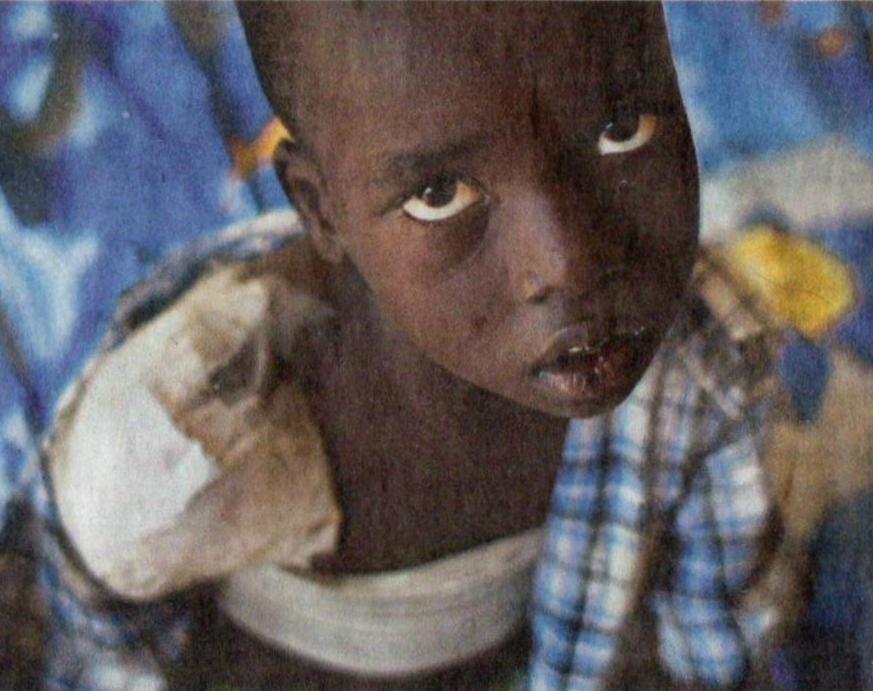
South Sudan History: Civil Intra-tribal War (2013)

Figure 1.-- Heavy civikian casualties including ethnically based attriciries havebeen reported in Siouth Sudan durung the outbrarl of open warfare in 2013. The press aption here read, "Atem Apieth, 6, who was wounded during recent fighting in Bor and managed to travel for treatmebnt to the capital by boat, recovers at the Juba Military Hospital in Juba, South Sudn. Hundreds have died in the war0-torn country." Photographer: Ben Curtis.
|
|
Well before independence, South Sudan society was badly fractured between the historically dominant Dinka and
the Neur. A substantial number of civilian casualties were the result of this ethnic tension while headlkines covered mostlt the conflict with the fundamentalist-dominated Islamic Government in Khartoum. An effort was made to end the ethnic tensions in the south at indepandence, Salva Kiir a Dinka became president and supporter Riek Machar, a Neur, became vice president. The power sharing did not work. President Kiir dismissed Machar and accused him of pllanning a coup. Fighting broke out between the Dinka-dominated Government and Neur rebels. And the ethnic tensiions involved has led to apauling attrocities. A U.N. official who conducted a fact-findung missiion described 'horror', including extrajudicial killings, sexual violence, and massacres committed at the hands of both the Dinka and Dur. Some 2.5 million people are believed to have died in the civil war between gthe north and south as a result of the fighting, attrocities, disease, and famine. Authorities are concerned that the rift between Machar and Kiir and their temperment may make the initial round of fighting the precursor of a long, brutal conflict is high. The issue appears to be historic dominant role of the Dinka, the largest tribal group in South Sudan. The conflict is not a simple matter. They like other tribal grouops are divided into different clans and subclans over a huge expanse of East Africa. After the Civil War with the south ended, manu military commandrs (often Dinka) claimed land. This appears to have been the case around Juba which is part of the reason why fighting broke out there. Also at issue is the countrty's oil resource. Much of it is located in Macharís home region, Unity State, south of the border with Sudan. This was one reasion the Sudan Government did not want to grant independence to the south. Machar complains that the local people are not benefitting from the oil exports. He charges that the oil money has been used as a personal reward for the Dinka military commanders who fought the war for wimming the war against the Khartoum Government.
HBC

Navigate the Boys' Historical Clothing Web Site:
[Introduction]
[Activities]
[Biographies]
[Chronology]
[Cloth and textiles]
[Clothing styles]
[Countries]
[Topics]
[Bibliographies]
[Contributions]
[FAQs]
[Glossaries]
[Images]
[Links]
[Registration]
[Tools]
[Boys' Clothing Home]
Navigate the Boys' Historical Clothing national pages:
[Return to the Main South Sudan history page]
[Return to the Main South Sudan page]
[Return to the Main African country history page]
[Return to the Main African page]
[Return to the Main tribal page]
[Algeria]
[Angola]
[Cape Verde]
[Congp]
[Egypt]
[Ethiopia]
[Ganon]
[Ivory Coast]
[Kenya]
[Lessothor]
[Madagascar]
[Mali]
[Somalia]
[South Africa]
[Sudan]
[Uganda]
[Zimbanwe]
Created: 8:23 PM 1/25/2014
Last updated: 8:23 PM 1/25/2014



